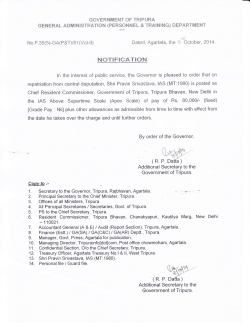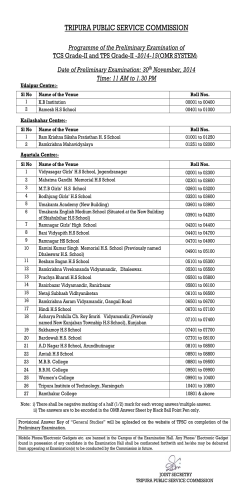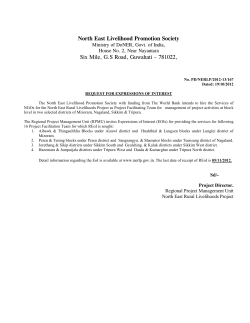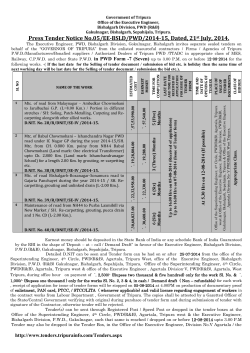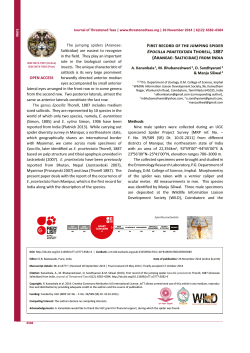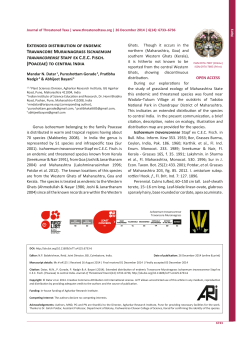
Diversity and field status of lianas in Tripura, India
Diversity and field status of lianas in Tripura, India Lalawmkima Darlong 1 & Debjyoti Bhattacharyya 2 Plant Taxonomy and Biosystematics Laboratory, Department of Life Science and Bioinformatics, Assam University, Silchar, Assam 788011, India 1 [email protected], 2 [email protected] (corresponding author) 1,2 ISSN 0974-7907 (Online) ISSN 0974-7893 (Print) OPEN ACCESS the supporting tree canopy to get the maximum sunlight for their metabolism. The lianas play a very important role in the composition of the plant community in tropical and subtropical forests, and the presence of lianas is one of the important physiognomic features for identifying tropical lowland and lower montane forests (Grubb 1977). While working on the morpho-taxonomy of lianas in Tripura, India, a checklist was prepared from literature (Hooker 1875, 1879, 1882, 1885, 1890, 1894; Deb 1981, 1983) which reveals that there are about 60 species of lianas in the state. During field visits to different places in Tripura from October 2010 to February 2013 the authors could collect only 34 species of lianas belonging to 18 families (Images 2 & 3). From the field observations, it has been found that the maximum numbers of species are distributed at different altitudes and habitats of Jampui Hill ranges, Kanchhanpur, Longtarai Valley, Gandacherra and Shipahijala Wildlife Sanctuary. It was noticed that the status and distribution of lianas are Abstract: A checklist of lianas in Tripura, India was prepared which enumerates about 60 species of lianas in the state. In this present paper, diversity of lianas in Tripura was analyzed by field exploration from October 2010 to February 2013. Out of the total 60 species enumerated, 34 species are provided with their phenology and places of occurrence . Field photographs are also given to facilitate their easy identification. Other 26 species could not be traced in the field and are represented only by herbarium specimens. Keywords: Checklist, diversity, lianas, Tripura. The lianas, commonly called woody climbers, are abundantly distributed in the tropical regions of the globe. The morphological diversity, twinning pattern and various mechanisms of seed dispersal have contributed towards their curious growth form in the plant world. In spite of the fact, in most of the floristic studies, lianas have always been overlooked and ignored. They germinate and produce roots in the ground and use coexisting tree species or other supports for their growth (Image 1). In general, their basal main stems are leafless and gigantic but they form a thick and dense cover on Gnetum oblongum NOT EVALUATED DATA DEFICIENT LEAST CONCERN NEAR THREATENED VULNERABLE ENDANGERED CRITICALLY ENDANGERED EXTINCT IN THE WILD EXTINCT NE DD LC NT VU EN CR EW EX DOI: http://dx.doi.org/10.11609/JoTT.o3575.6703-10 Editor: B. Ravi Prasad Rao, Sri Krishnadevaraya University, Anantapur, India. Date of publication: 26 December 2014 (online & print) Manuscript details: Ms # o3575 | Received 02 April 2013 | Final received 30 June 2014 | Finally accepted 20 October 2014 Citation: Darlong, L. & D. Bhattacharyya (2014). Diversity and field status of lianas in Tripura, India. Journal of Threatened Taxa 6(14): 6703–6710; http://dx.doi. org/10.11609/JoTT.o3575.6703-10 Copyright: © Darlong & Bhattacharyya 2014. Creative Commons Attribution 4.0 International License. JoTT allows unrestricted use of this article in any medium, reproduction and distribution by providing adequate credit to the authors and the source of publication. Funding: University Grants Commission (UGC), New Delhi. [F. 14-2 (ST)/2010 (SA-III) dated 24th June 2011]. Competing Interest: The authors declare no competing interests. Acknowledgements: The authors extend their sincere thanks to the Forest Department of Tripura for giving them permission to survey different protected areas. They are also thankful to the Head, Botanical Survey of India (ASSAM and CAL) for permitting them to consult herbaria and libraries. Thanks are also due to the head, Department of Life Science and Bioinformatics, Assam University, Silchar for providing necessary facilities. 6703 Short Communication Journal of Threatened Taxa | www.threatenedtaxa.org | 26 December 2014 | 6(14): 6703–6710 ĂƌůŽŶŐΘŚĂƩĂĐŚĂƌLJLJĂ D Ξ>ĂůĂǁŵŬŝŵĂĂƌůŽŶŐ ŝǀĞƌƐŝƚLJŽĨůŝĂŶĂƐŝŶdƌŝƉƵƌĂ /ŵĂŐĞϭ͘dǁŝŶŶŝŶŐƉĂƩĞƌŶŽĨƐŽŵĞŐŝĂŶƚůŝĂŶĂƐŝŶƚŚĞŝƌŶĂƚƵƌĂů ŚĂďŝƚĂƚ͘ͲƵƚĞĂƉĂƌǀŝŇŽƌĂZŽdžď͖͘ͲParabarium micranthum;͘ ͘ͿWŝĞƌƌĞ͖ͲŶƚĂĚĂƉŚĂƐĞŽůŽŝĚĞƐ;>͘ͿDĞƌƌ͖͘ͲCissus repanda sĂŚů͘;>Eс>ŝĂŶĂ͖^Wс^ƵƉƉŽƌƟŶŐWůĂŶƚͿ͘ ĚŝƌĞĐƚůLJ ĚĞƉĞŶĚĂŶƚ ďŽƚŚ ŽŶ ƚŚĞ ĞŶǀŝƌŽŶŵĞŶƚĂů ĨĂĐƚŽƌƐ ĂŶĚƚŚĞŚŽƐƚƐƉĞĐŝĞƐ͘ ^ƚƵĚLJ ĂƌĞĂ͗ dƌŝƉƵƌĂ͕ ƚŚĞ ƐĞĐŽŶĚ ƐŵĂůůĞƐƚ ƐƚĂƚĞ ŝŶ ŶŽƌƚŚĞĂƐƚĞƌŶ /ŶĚŝĂ͕ ŝƐ ŵĂŝŶůLJ Ă ĨŽƌĞƐƚ ĚŽŵŝŶĂƚĞĚ ƐƚĂƚĞ ůLJŝŶŐ ďĞƚǁĞĞŶ ƚŚĞ ĐŽŽƌĚŝŶĂƚĞƐ ϮϯϬϯϬ͛ʹϮϯϬϰϰ͛E Θ ϵϭϬϭϱ͛ʹϵϭϬϮϴ͛͘ dŚĞsƚĂƚĞŝƐƐƵƌƌŽƵŶĚĞĚŽŶƚŚƌĞĞƐŝĚĞƐ ďLJĂĚĞůƚĂŝĐďĂƐŝŶŽĨĂŶŐůĂĚĞƐŚ͘ džĐĞƉƚĨŽƌĂƉŽƌƟŽŶŽĨ ƚŚĞ ĞĂƐƚĞƌŶ ďŽƵŶĚĂƌLJ ǁŝƚŚ DŝnjŽƌĂŵ ĂŶĚ ŶŽƌƚŚĞĂƐƚĞƌŶ ďŽƵŶĚĂƌLJ ǁŝƚŚ ƐƐĂŵ͕ Ăůů ĂƌĞ ďŽƵŶĚĞĚ ďLJ ƚŚĞ ŝŶƚĞƌŶĂƟŽŶĂůůŝŶĞǁŝƚŚĂŶŐůĂĚĞƐŚ;&ŝŐ͘ϭͿ͘ dŚĞĨŽƌĞƐƚƐŝŶ ƚŚĞƐƚĂƚĞĂƌĞŵĂŝŶůLJƚƌŽƉŝĐĂůĞǀĞƌŐƌĞĞŶ͕ƐĞŵŝĞǀĞƌŐƌĞĞŶ ĂŶĚŵŽŝƐƚĚĞĐŝĚƵŽƵƐŝŶŶĂƚƵƌĞ͘ dŚĞŐĞŽŐƌĂƉŚŝĐĂůĂƌĞĂ ŽĨƚŚĞƐƚĂƚĞŝƐĐa͘ϭϬ͕ϰϴϲŬŵ2ĂŶĚĂƉƉƌŽdžimatelyϳϳйŽĨ ƚŚĞƐƚĂƚĞ͛ƐŐĞŽŐƌĂƉŚŝĐĂůĂƌĞĂŝƐƵŶĚĞƌĨŽƌĞƐƚĐŽǀĞƌ͘ /Ŷ ƚĞƌŵƐ ŽĨ ĨŽƌĞƐƚ ĐĂŶŽƉLJ ĚĞŶƐŝƚLJ ĐůĂƐƐĞƐ͕ ƚŚĞ ^ƚĂƚĞ ŚĂƐ ĂƌŽƵŶĚϲϲ͘ϯϯйƌĞƐĞƌǀĞĚĨŽƌĞƐƚƐ͕Ϭ͘ϬϯйƉƌŽƚĞĐƚĞĚĂƌĞĂƐ ĂŶĚϯϯ͘ϲϰйƵŶĐůĂƐƐŝĮĞĚĨŽƌĞƐƚƐ;ŶŽŶLJŵŽƵƐϮϬϬϵͿ͘ Ɛ ƉĞƌ ƚŚĞ ĐůĂƐƐŝĮĐĂƟŽŶ ďLJ ŚĂŵƉŝŽŶ Θ ^ĞƚŚ ;ϭϵϲϴͿ ĂŶĚ ŶŽŶLJŵŽƵƐ;ϮϬϭϭͿ͕ƚŚĞƐƚĂƚĞŚĂƐƚǁŽďƌŽĂĚŐƌŽƵƉƐŽĨ ĨŽƌĞƐƚƐ,ǀŝnj͘, ƚƌŽƉŝĐĂůƐĞŵŝĞǀĞƌŐƌĞĞŶĨŽƌĞƐƚƐĂŶĚƚƌŽƉŝĐĂů ŵŽŝƐƚ ĚĞĐŝĚƵŽƵƐ ĨŽƌĞƐƚƐ͘ dŚĞ ĐůŝŵĂƚĞ ŽĨ ƚŚĞ ƐƚĂƚĞ ŝƐ ĐŚĂƌĂĐƚĞƌŝnjĞĚ ďLJ ŵŽĚĞƌĂƚĞ ƚĞŵƉĞƌĂƚƵƌĞ ;Ϯϭʹϯϴ Ϭ ŝŶ ϲϳϬϰ &ŝŐƵƌĞϭ͘ŽůůĞĐƟŽŶƐŝƚĞƐŝŶƚŚĞƐƚƵĚLJĂƌĞĂdƌŝƉƵƌĂ ƐƵŵŵĞƌĂŶĚϰʹϯϯ ϬŝŶǁŝŶƚĞƌͿĂŶĚŚŝŐŚŚƵŵŝĚŝƚLJǁŝƚŚ ĂŶĂǀĞƌĂŐĞĂŶŶƵĂůƌĂŝŶĨĂůůŽĨϮϭϬϵŵŵ͕ǁŚŝĐŚŝƐŵŽƐƚůLJ ƌĞĐĞŝǀĞĚĚƵƌŝŶŐƚŚĞƐŽƵƚŚͲǁĞƐƚŵŽŶƐŽŽŶ ƐĞĂƐŽŶ͘ dŚĞ ƉƌŝŶĐŝƉĂůŚŝůůƌĂŶŐĞƐŝŶƚŚŝƐƐƚĂƚĞĂƌĞ:ĂŵƉƵŝ͕^ĂŬŚĂŶƚůĂŶŐ͕ >ĂŶŐƚĂƌĂŝ͕ ƚŚĂƌŽŵƵƌĂ ĂŶĚ ĂƌĂŵƵƌĂͲĞďƚĂŵƵƌĂ͘ ƌŽƵŶĚ ϲϬϯ͘ϲϰŬŵ2 ŽĨ ĂƌĞĂ ŝƐ ƵŶĚĞƌ ƌĞƐĞƌǀĞĚ ĨŽƌĞƐƚƐ ŝŶ dƌŝƉƵƌĂ ǁŚŝĐŚ ŝŶĐůƵĚĞƐ ƚǁŽ nĂƟŽŶĂů ƉĂƌŬƐ ĂŶĚ ĨŽƵƌ ǁŝůĚůŝĨĞsĂŶĐƚƵĂƌŝĞƐ;ŶŽŶLJŵŽƵƐϮϬϭϭͿ͘ DãÙ®½ÝÄDã«ÊÝ dŚĞ ƉƌĞƐĞŶƚ ƐƚƵĚLJ ŝƐ ƉƌŝŵĂƌŝůLJ ďĂƐĞĚ ŽŶ ĞdžƚĞŶƐŝǀĞ ĂŶĚŝŶƚĞŶƐŝǀĞĮĞůĚǀŝƐŝƚƐƚŽĚŝīĞƌĞŶƚĂƌĞĂƐŽĨƚŚĞƐƚƵĚLJ ĂƌĞĂ͘ ŽůůĞĐƟŽŶƐ ǁĞƌĞ ŵĂĚĞ ĚƵƌŝŶŐ ĚŝīĞƌĞŶƚ ƐĞĂƐŽŶƐ ;ƐƵŵŵĞƌ͕ƉƌĞͲŵŽŶƐŽŽŶ͕ƉŽƐƚͲŵŽŶƐŽŽŶ͕ǁŝŶƚĞƌŽĨϮϬϭϬ ƚŽϮϬϭϯͿĂŶĚĞĂĐŚƐƵƌǀĞLJǁĂƐŽĨϭϬʹϮϬĚĂLJƐĚƵƌĂƟŽŶ͘ &ŝĞůĚ ǀŝƐŝƚƐ ǁĞƌĞ ŵĂĚĞ ƚŽ ĚŝīĞƌĞŶƚ ĨŽƌĞƐƚ ĚŽŵŝŶĂƚĞĚ ĂƌĞĂƐŽĨƚŚĞstate,ǀŝnj͘,'ĂŶĚĂĐŚĞƌĂĂŶĚ>ŽŶŐƚĂƌĂŝǀĂůůĞLJ ;ŚĂůĂŝ ŝƐƚƌŝĐƚͿ͕ ŚĂƌŵĂŶĂŐĂƌ͕ <ĂŶĐŚĂŶƉƵƌ͕ :ĂŵƉƵŝ Śŝůů ƌĂŶŐĞ ĂŶĚ WĂŶŝƐĂŐĂƌ ;EŽƌƚŚ ŝƐƚƌŝĐƚͿ͕ <ƵŵĂƌŐŚĂƚ ĂŶĚ <ĂŝůĂƐŚĂŚĂƌ ;hŶŽŬŽƟ ŝƐƚƌŝĐƚͿ͕ ŵĂƌƉƵƌ ĂŶĚ <ĂƌŬ;'ŽŵĂƟŝƐƚƌŝĐƚͿĂŶĚŝƐŚĂůŐŚĂƌĂŶĚ^ŽŶĂŵƵƌĂ ;^ŚŝƉĂŚŝũĂůĂŝƐƚƌŝĐƚͿ͘ &ŽƵƌĚŝīĞƌĞŶƚǁŝůĚůŝĨĞsĂŶĐƚƵĂƌŝĞƐ Journal of Threatened Taxa | www.threatenedtaxa.org | 26 December 2014 | 6(14): 6703–6710 Diversity of lianas in Tripura Darlong & Bhattacharyya viz. Shipahijala, Trishna, Gomati and Rowa were also surveyed. The collected plant materials were made into herbarium specimens following standard technique (Jain & Rao 1977; Singh & Subramaniam 2008). After collection the flowers were dissected under Olympus SZ61 Stereo Zoom Dissecting Microscope and the plants were critically studied; identification of taxa was done following standard floras. Identifications were confirmed by matching our collected specimens with identified specimens housed in CAL & ASSAM, and sometimes with available type and other authentic specimens, as well as by consultations of relevant taxonomic literature. Specimens collected from the study area during the present study are housed in the herbarium of Department of Life Science & Bioinformatics, Assam University, Silchar. Field photographs have been taken with Nikon Coolpix camera. Results and Discussion A checklist prepared from the literature (Hooker 1875–1890; Deb 1981–83) reveals the occurrence of 60 species of lianas in Tripura. Of the 60, only 34 species could be located and collected in the present study (Table 1). Among the 34 species, two species are gymnosperms; the remaining 32 species are distributed under 18 angiospermic families. The most dominant family recorded was Papilionaceae (6), followed by Apocynaceae (4) and Combretaceae (4). Table 2 represents a list of the other 26 species which could not be traced during the study period but have their representative specimens in CAL and ASSAM. The largest genus was Combretum Loefl. with three species, followed by Cissus L. and Byttneria Loefl. with two species each. Combretum punctatum Blume subsp. squamosus (Roxb. ex G. Don) Exell, Millettia pachycarpa Benth., Thunbergia grandiflora (Roxb. ex Rottl.) Roxb. and Cissus adnata Roxb. were very common throughout their habitat. Combretum punctatum Blume subsp. squamosus (Roxb. ex G. Don) Exell and Millettia pachycarpa Benth. were also very common in the state; the former generally grows along the roadside of the forest areas and the latter in ‘Sal’ forests. In contrast, Pueraria tuberose (Roxb. ex Willd.) DC., Uncaria sessilifructus Roxb. and Byttneria aspera Collb. could only be seen in Chawmanu, Serhmun and Betlingship areas. Two gymnospermic species Gnetum montanum Table 1. Enumeration of species of lianas in Tripura with their phenology, collection sites and collection/field numbers Family Scientific name Phenology Locality/Place of occurrence 1. Acanthaceae Thunbergia grandiflora (Roxb. ex Rottl.) Roxb. Fl.: Jun-Sep Fr.: Aug-Mar 2. Annonaceae Desmos dumosus (Roxb.) Safford Beaumontia grandiflora (Roxb.) Wall. Ichnocarpus frutescens (L.) R. Br. Parabarium micranthum (A. DC.) Pierre Fl.: Apr-Aug Fr.: Jul-Apr Fl.: Jan-Mar Fr.: Mar-Apr Fl.: May-Aug Fr.: Aug-Dec Fl.: May-Jul Fr.: Aug-Sep Fl.: Jan-Apr Fr.: May-Jul Fl.: Oct-Nov Fr.: Oct-Dec Fl.: Oct-Nov Fr.: Nov-Dec Fl.: Apr-May Fr.: Aug-Oct Fl.: Jan-Apr Fr.: Dec-Feb Nalkata & Chawmanu, Dhalai District; Pecharthal, Unokoti District; Shipahijala Wildlife Sanctuary, Shipahijala Distict; Amarpur & Karbook, Gomati Distict 3. 4. 5. Apocynaceae 6. Willughbeia edulis Roxb. 7. Bauhinia scandens Roxb. 8. 9. Caesalpiniaceae Capparaceae 10. 11. Combretaceae Mezoneuron cuculatum (Roxb.) Wight & Arn. Stixis suaveolens (Roxb.) Pierre Combretum dasystachyum Kurz Combretum punctatum Blume subsp. squamosus (Roxb. ex G. Don) Exell C. roxburghii Spreng. 12. Quisqualis indica L. 13. 14. Connaraceae 15. Cucurbitaceae 16. Dilleniaceae Connarus paniculatus Roxb. Hodgsonia macrocarpa (Blume) Cogn. Tetracera sarmentosa (L.) Vahl. Fl.: Mar-Apr Fr.: Apr-Jul Fl.: Aug-Oct Fr.: Oct-Jan Fl.: Mar-Nov Fr.: Jun-Nov Fl.: Aug-Oct Fr.: Oct-Dec Fl.: Jan-Mar Fr.: Aug-Feb Fl.: Apr-Jun Fr.: Jul-Aug Nalkata, Dhalai District S. K. Para & Moracherra, Dhalai District; Jolai, North Tripura District Serhmun, Unokoti District; Joyshree & Damcherra, North Tripura District; Nalkata, Dhalai District Phuldungsai, North Tripura District Chawmanu & Manikpur, Dhalai District; Shipahijala Wildlife Sanctuary, Shipahijala District Ambassa & Nalkata, Dhalai District; Shermun & Sabual, North Tripura District; Hmuntha, Unokoti District Damcherra, North Tripura District Collection number/ Field No. L. Darlong 10302 L. Darlong 10312 L. Darlong 10306 L. Darlong 10331, 10337 L. Darlong 10319 L. Darlong 10340 L. Darlong 10310, 10338 L. Darlong 10329, 10333 Nalkata, Dhalai District L. Darlong 10324 Chawmanu, Dhalai District L. Darlong 10315 Koramcherra & Nalkata, Dhalai District; Kanchanpur, North Tripura District; Trishna Wildlife Sanctuary, Gomati District L. Darlong 10322, 10344 Ambassa, Devipur & Nalkata, Dhalai District; L. Darlong 10301 Nalkata, Dhalai District; Udaipur, Amarpur & Karbook, Gomati District; Hmuntha & Jolai, North Tripura District L. Darlong 10317 Nalkata, Dhalai District; Joyshree, North Tripura district L. Darlong 10328 Kanchancherra & Moracherra, Dhalai District; Hmunpuii & Jolai, North Tripura District Gondacherra & Chawmanu, Dhalai District; Chamtilla, North Tripura District Journal of Threatened Taxa | www.threatenedtaxa.org | 26 December 2014 | 6(14): 6703–6710 L. Darlong 10305 L. Darlong 10367 6705 Diversity of lianas in Tripura 17. Gnetaceae 18. 19. Mimosaceae 20. Moraceae Darlong & Bhattacharyya Gnetum oblongum Markgraf Fl.: Jan-Mar Fr.: Apr-Jul Gnetum montanum Markgraf Fl.: Feb-Mar Fr.: Apr-Jun Entada phaseoloides (L.) Merr. Poikilospermum suaveolens (Blume) Merr. Fl.: Jun-Jul Fr.: Aug-Apr Fl.: Mar-Apr Fr.: Apr-May Butea parviflora Roxb. 22. Dalhousiea bracteata (Roxb.) R. Grah. ex Wight 23. Papilionaceae 24. 25. 26. 27. 28. 29. 30. 31. 32. 33. Rhamnaceae Rubiaceae Smilacaceae Sterculiaceae Vitaceae Derris trifoliata Lour. Millettia pachycarpa Benth. Pueraria montana var. chinensis (Ohwi) Sanjappa & Pradeep Pueraria tuberosa (Roxb. ex Willd.) DC. Ventilago madraspatana Gaertn. var. calyculata (Tulasne.) King Paederia foetida L. Uncaria sessilifructus Roxb. Smilax zeylanica L. Byttneria aspera Collb. Byttneria pilosa Roxb. Cissus adnata Roxb. Cissus repanda Vahl. 34. Chamtilla & Sabual, North Tripura District; Nalkata, Koramcherra & Gondacherra, Dhalai District; Trishna Wildlife Sanctuary, Gomati District Devipur & Chawmanu, Dhalai District; Phuldungsai, Vanghmun & Damcherra, North Tripura District Pecharthal, Unokoti District; Damcherra, North Tripura District L. Darlong 10309, 10339 L. Darlong 10307, 10342 L. Darlong 10325, 10336 Fl.: May-Jun Fr.: Jun-Oct Fl.: Jun-Jul Fr.: Aug-Oct Fl.: Mar-May Fr.: Aug-Oct Chawmanu, Moracherra & Kunkicherra, Dhalai District; Joyshree, North Tripura District; Unokoti, Unokoti District; Shipahijala Wildlife Sanctuary, Shipahijala District; Karbook, Udaipur & Amarpur, Gomati District Nalkata & Koramcherra, Dhalai District; Boithang & Joyshree, North Tripura District Gomati Wildlife Sanctuary, Gomati District; Nalkata, Dhalai District Chawmanu, Dhalai District; Joyshree, Pipla & Hmunpuii, North Tripura District Fl.: Aug-Oct Fr.: Oct-Nov Dumacherra & Kunkicherra, Dhalai District; Serhmun, North Tripura District; Kailashahar, Unokoti District L. Darlong 10321 Fl.: Apr-May Fr.: May-Jun Chawmanu, Dhalai District L. Darlong 10314 Fl.: Feb-Mar Fr.: Mar-May Nalkata (Debbarma basti), Dhalai District L. Darlong 10387 Nalkata, Dhalai District; Serhmun, North Tripura District L. Darlong 10388, 10389 Kathalcherra, Dhalai District; Serhmun, North Tripura District L. Darlong 10326 Devipur, Dhalai District; Shipahijala Wildlife Sanctuary, Shipahijala District L. Darlong 10327 Sabual, Phuldungsai & Vanghmun, North Tripura District L. Darlong 10318 Jolai, North Tripura District; Laljuri, Nalkata & Koramcherra, Dhalai District Jolai & Rowa Wildlife Sanctuary, North Tripura district; Nalkata, Dhalai District Birasi miles (Sal forest), Dhalai District; Amarpur, Trishna Wildlife Sanctuary, Gomati District; Shipahijala Wildlife Sanctuary, Shipahijala District L. Darlong 10323, 10334 Fl.: Aug-Sep Fr.: Oct-Nov 21. L. Darlong 10365 Chamtilla, North Tripura District Fl.: Aug-Oct Fr.: Oct-Dec Fl.: Jun-Oct Fr.: Jun-Oct Fl.: Aug-Sep Fr.: Oct-Dec Fl.: May-Jul Fr.: July-Aug Fl.: Sep-Oct Fr.: Nov-Feb Fl.: Jun-Jul Fr.: Aug-Oct Fl.: Apr-May Fr.: May-Jun L. Darlong 10303, 10343, 10347 L. Darlong 10345,10346 L. Darlong 10363 L. Darlong 10313, 10330, 10332 L. Darlong 10335 L. Darlong 10311, 10320 Table 2. The species of lianas which could not be traced in the field during recent explorations in Tripura Family Scientific name Voucher specimens 14. Abrus precatorius L. Debbarma 1043 15. Dalbergia thomsonii Benth. Deb 1043, 1760 16. D. volubilis Roxb. Deb 2866, 1079 17. Millettia extensa Benth. ex Baker Deb 1714, 2604 Mucuna bracteata DC. Deb 26947; Kashari 1211 Fissistigma bicolor (Roxb.) Merr. Deb 1745; Debbarma 1118 2. F. verrucosum (Hook.f. & Thomson) Merr. Deb 27035 3. Vallaris solanacea (Roth) Kuntze Deb 2780; Debbarma 1080 18. Convolvulaceae Erycibe peguensis Prain Deb 2070; Debbarma 914 19. M. nigricans Steud. Deb 351 Cucurbitaceae Trichosanthes bracteata Voigt Deb 1075, 1381 20. Mucuna pruriens (L.) DC. Deb 2444 Aspidopterys elliptica A. Juss. Deb 27268 21. Rhynchosia sericea Gillies ex Deb 27472 Hook. & Arn. 7. Hiptage benghalensis (L.) Kurz Deb 2761; Debbarma 1033 8. Cocculus hirsutus (L.) Diels Deb 26864 1. Annonaceae 4. 5. Apocynaceae 6. Malpighiaceae 9. 10. Menispermaceae Pycnarrhena pleniflora Deb 2794 Miers ex Hook.f. & Thomson Mimosaceae Acacia pruinescens Kurz Biswas 5065; Deb 1004 Jasminum caudatum Wall. ex Lindl. Deb 27293 J. coarctatum Roxb. Biswas 4911 J. subtriplinerve Blume Deb 26857 11. 12. 13. 6706 Oleaceae Papilionaceae Sabia limoniacea Wall. ex Hook. f. & Thomson Deb 27298 Ampelocissus barbata (Wall.) Planch. Deb 113 Tetrastigma lanceolarium (Roxb.) Planch. Deb 27200 25. T. obovatum Gagnep. Deb 2720 26 T. serrulatum (Roxb.) Planch. Deb 2287, 27255 22. Sabiaceae 23. 24. Vitaceae Journal of Threatened Taxa | www.threatenedtaxa.org | 26 December 2014 | 6(14): 6703–6710 © Lalawmkima Darlong Darlong & Bhattacharyya © Lalawmkima Darlong Diversity of lianas in Tripura © Lalawmkima Darlong Image 2B. Uncaria sessilifructus Roxb Image 2C. Stixis suaveolens © Lalawmkima Darlong Image 2A. Combretum punctatum Blume ssp. squamosus Image 2F. Beaumontia grandiflora © Lalawmkima Darlong © Lalawmkima Darlong Image 2E. Pueraria montana var. chinensis Image 2D. Byttneria pilosa © Lalawmkima Darlong Image 2G. Dalhousiea bracteata © Lalawmkima Darlong © Lalawmkima Darlong Image 2I. Connarus paniculatus Image 2H. Pueraria tuberosa Image 2J. Combretum roxburghii Journal of Threatened Taxa | www.threatenedtaxa.org | 26 December 2014 | 6(14): 6703–6710 6707 Darlong & Bhattacharyya Image 2M. Millettia pachycarpa © Lalawmkima Darlong Image 2K. Hodgsonia macrocarpa © Lalawmkima Darlong © Lalawmkima Darlong Image 2L. Entada phaseoloides © Lalawmkima Darlong © Lalawmkima Darlong © Lalawmkima Darlong Diversity of lianas in Tripura Image 2O. Bauhinia scandens Image 2N. Butea parviflora Image 2P. Tetracera sarmentosa Markgraf and G. oblongum Markgraf have already been categorized as threatened in the state (Deb 1999). Felling of supporting/host trees for Jhum cultivation and wood commerce viz., Artocarpus chama Buch.Ham. (Moraceae), Shorea robusta C.F.Gaertn. (Dipterocarpaceae), Tectona grandis L.f. (Lamiaceae), utilization of some lianas for ethnic uses, clearing of forests for agriculture, are identified as some of the major threats to this highly important growth form in the state. Moreover, rubber and ‘supari’ (areca nut) plantations, tea and pineapple cultivation are the main sources of livelihood of the rural and tribal people of Tripura. These practices are also alarming threats for different species of lianas growing in the state (Darlong & Bhattacharyya 2012). So, proper in situ conservation is prescribed for their sustenance. Seeds can also be 6708 collected for seed banks. Moreover, ex situ conservation in botanic gardens is recommended. References Anonymous (2009). The State of Forest Report. Forest Survey of India, Dehradun, India, 151–153pp. Anonymous (2011). India State of Forest Report. Forest Survey of India, Ministry of Environment & Forests, Government of India, 225–229pp. Champion, H.G. & S.K. Seth (1968). A Revised Survey of the Forest Types of India. Government of India Publication, New Delhi, 404pp. Darlong, L. & D. Bhattacharyya (2012). Some lianas in Tripura, India, demand urgent conservation efforts. Current Science 102(9): 1246. Deb, D.B. (1981). The Flora of Tripura State. Vol 1. Today and Tomorrow’s Printers and Publishers, New Delhi, xviii+509pp. Deb, D.B. (1983). The Flora of Tripura State. Vol. 2. Today and Tomorrow’s Printers and Publishers, New Delhi, xi+601pp. Deb, D.B. (1999). Tripura, pp. 1511–1525. In: Mudgal, V. & P.K. Hajra (eds.). Floristic Diversity and Conservation Strategies in India - Vol. Journal of Threatened Taxa | www.threatenedtaxa.org | 26 December 2014 | 6(14): 6703–6710 Darlong & Bhattacharyya © Lalawmkima Darlong © Lalawmkima Darlong © Lalawmkima Darlong Diversity of lianas in Tripura Image 3A. Thunbergia grandiflora Image 3C. Paederia foetida © Lalawmkima Darlong © Lalawmkima Darlong Image 3B. Quisqualis indica © Lalawmkima Darlong Image 3D. Combretum dasystachyum Image 3F. Ichnocarpus frutescens Image 3G. Mezoneuron cuculatum Image 3H. Poikilospermum suaveolens Journal of Threatened Taxa | www.threatenedtaxa.org | 26 December 2014 | 6(14): 6703–6710 © Lalawmkima Darlong © Lalawmkima Darlong © Lalawmkima Darlong Image 3E. Smilax zeylanica Image 3I. Ventilago madraspatana Gaertn. var. calyculata 6709 Darlong & Bhattacharyya © Lalawmkima Darlong Image 3J. Byttneria aspera © Lalawmkima Darlong © Lalawmkima Darlong Diversity of lianas in Tripura Image 3K. Desmos dumosus Image 3L. Parabarium micranthum Image 3Q. Gnetum oblongum Image 3R. Gnetum montanum Image 3N. Willughbeia edulis © Lalawmkima Darlong © Lalawmkima Darlong Image 3M. Derris trifoliata Image 3O. Cissus repanda © Lalawmkima Darlong © Lalawmkima Darlong © Lalawmkima Darlong © Lalawmkima Darlong Image 3P. Cissus adnata 3. Botanical Survey of India, Calcutta. Grubb, P.J. (1977). Control of forest growth and distribution on wet tropical mountains with special reference to mineral nutrition. Annual Review of Ecology and Systematics 8: 83–107. Hooker, J.D. (1875). The Flora of British India - Vol. 1. L. Reeve & Co., London, viii+1-740pp. Hooker, J.D. (1879). The Flora of British India - Vol. 2. L. Reeve & Co., London, 792pp. Hooker, J.D. (1882). The Flora of British India - Vol. 3. L. Reeve & Co., London, 712pp. Hooker, J.D. (1885). The Flora of British India - Vols. 4. L. Reeve & Co., London, 780pp. Hooker, J.D. (1890). The Flora of British India - Vols. 5. L. Reeve & Co., London, 910pp. Hooker, J.D. (1894). The Flora of British India - Vols. 6. L. Reeve & Co., London, 793pp. Jain, S.K. & R.R. Rao (1977). A Handbook of Field and Herbarium Methods. Today & Tomorrow’s Printers and Publishers, New Delhi, xvi+157pp. Singh, H.B. & B. Subramaniam (2008). Field Manual on Herbarium Techniques. National Institute of Science Communication and Information Resources (NISCAIR), CSIR, New Delhi, 298pp. Threatened Taxa 6710 Journal of Threatened Taxa | www.threatenedtaxa.org | 26 December 2014 | 6(14): 6703–6710
© Copyright 2026
